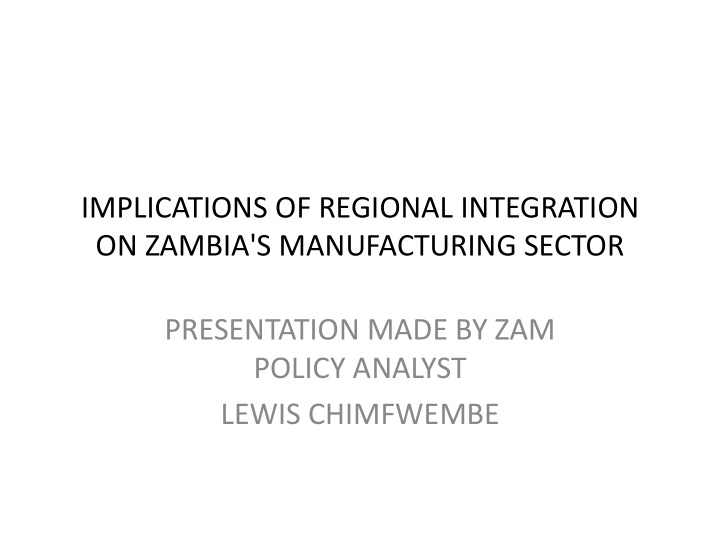



IMPLICATIONS OF REGIONAL INTEGRATION ON ZAMBIA'S MANUFACTURING SECTOR PRESENTATION MADE BY ZAM POLICY ANALYST LEWIS CHIMFWEMBE
STRUCTURE • Background • Zambia’s trade • Manufacturing sector • Implications • Recommendations
BACKGROUND • According to Winter (1996), regional integration refers to any policy designed to reduce trade barriers between a subset of countries regardless of whether those countries are actually contiguous or even close to each other. • There are many Regional Economic Communities (RECs) in the world and Zambia is part of, among others, SADC, COMESA and the newly launched TFTA (EAC_SADC_COMESA)
ZAMBIA’S TRADE • In the last quarter of 2008 Zambia’s total trade was US $2,138.2 million. By the last quarter of 2009 total trade grew to US $2,469.7 million. Of this trade, Switzerland accounted for 22.5 %, South Africa 7.8% and Congo (DR) 29.7%. • During the first quarter of 2011, Zambia’s total trade grew to US 3,681.62 million. South Africa was Zambia’s second largest trading partner accounting for US$720.2 million, the DRC came third accounting for US $493.1 million while Zimbabwe accounted for US $60.8 million. • During the period beginning second quarter of 2011 to second quarter 2012, the top trading partners for Zambia in the SADC and COMESA Region were South Africa accounting for US956.1 million, Congo (DR) accounting for US $412.9 million and Zimbabwe accounting for US$ 109.8 million. • During the period beginning first quarter of 2014 to first quarter 2015, Zambia’s top trading partners in SADC and COMESA region were South Africa on top accounting for US $767.0 million, Congo (DR) accounting for US $429.8 million, Zimbabwe accounting for US $77.1 million and Egypt accounting for US $6.5 million.
ZAMBIA’S MAJOR EXPORT COMMODITIES • To South Africa ; cotton, raw hides, brans, sharps, other residues of maize, copper and articles, precious stones, base metals (including copper), electrical machinery parts and sugars and sugar confectioneries • To Congo DR : electrical energy, chemicals, sugar and sugar confectioneries, nuclear reactors, other machinery parts and inorganic chemicals (ibid). • To Zimbabwe , Malawi and Kenya : mineral fuels, cereals, soap, organic surface-active agents, maize, wood, candles, tapers, candles, industrial boilers, cereal, iron and steel, cereals, salt, sulphur, cotton, sugars and sugars confectionery • To Egypt: copper
MANUFACTURING SECTOR • Manufacturing is of strategic importance to sustained socio- economic development in Zambia. The sector has potential for diversification of export content, foreign exchange earnings, employment and poverty reduction. • 1991 – 2000: Sector contributed 20 percent to GDP before remaining static in the last few years at about 8%. • 2000 to 2013: Sector recorded compounded annual growth rate of 5.5% (IGC, 2014). • Growth mainly underpinned by the food, tobacco and beverages sector; the basic metals and fabricated engineering sector; cement and chemicals, plastic and the rubber sector. • Employment creation: Increased from 55,600 in 2005 to 216,700 people in 2012 (IGC 2014).
IMPLICATIONS – BENEFITS • 1. WIDER MARKET - Economies of scale - Product diversity - Sectorial growth and employment creation SADC (excl.) and SADC and COMESA (dual) are third and fourth largest export markets for Zambia, respectively. Major exports to SADC, and ‘SADC and COMESA’ regions are: copper wire, electric cables, machinery parts, industrial boilers, mechanical appliances, metals, miscellaneous articles of metals, chemicals, fertilisers, cement, parts lime, food items, , tobacco, manufactured tobacco substitutes, cereals, sugars and, sugar confectionery, cigarettes, alcoholic beverages and cotton.
IMPLICATIONS – BENEFITS 2. COMPETITIVENESS - Domestic and foreign markets - Improvement in product quality - Domestic and foreign investment 3. CHEAPER INPUTS - Duty free inputs originating from FTA region 4. REGIONAL INTEGRATION EFFORTS - Trade Facilitation measures i.e One Stop Border Post - Dispute settlement i.e Leather and Zimbabwe
IMPLICATIONS – NEGATIVES • 1. INFANT INDUSTRY - Difficult for emerging industries to flourish - Almost impossible for new industries to emerge • 2. STAGNATION OF EXISTING FIRMS - Domestic market crowded - Bulk production and import tariff structure - Price and product quality competition • 3. INJURY TO DOMESTIC INDUSTRY - Injury to local industry . A surge in imports of products similar to those manufactured locally can cause injury to the local industry which if not addressed can cause local firms to shut down i.e Steel Industry
RECOMMENDATIONS • 1 . COMPETITIVE SOURCING OF INPUTS - Develop local input industry (entry point agriculture value chains) - Tax Policy alignment to trade policy - Reduction in Transport costs (improvement in infrastructure) - Simplify Border Procedures • 2. COMPLETIVE PRODUCTION - Enhance capacity National Quality Infrastructure (fragmentation) - Enhance capacity to invoke appropriate trade remedies timely - Put in place a deliberate local content policy - Access to reliable energy (competitive subsector) • 3. COMPETITIVE EXPORTATION - Economic infrastructure - Scale up efforts towards Trade facilitation measures - Timely handling of Non Tariff Barriers (NTBs) in export markets as well as domestically
Additional Information OPPORTUNITIES • Zambia’s trade with many SADC and COMESA countries remain significantly low. For example, exports to COMESA (exclusive) account for less than 5 per cent of Zambia’s total exports. • COMESA (exclusive) accounted for 1.8 percent of Zambia’s total exports in the second quarter of 2012 before declining to for 0.7 percent in the third quarter of 2013.. • Zambia’s export trade with SADC is concentrated mainly on three countries – South Africa, Zimbabwe and Congo DR. • SADC and COMESA have many members states. Thus, the dual present a very huge export market for Zambia products.
END Thank You For Your Attention!!!!!!
Recommend
More recommend